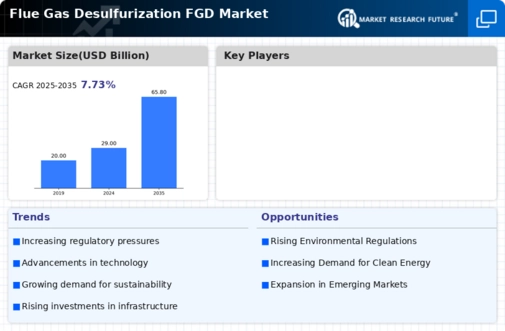Market Growth Projections
Investment in Renewable Energy Sources
The transition towards renewable energy sources is shaping the Global Flue Gas Desulfurization FGD Market Industry. As nations strive to reduce their carbon footprints, investments in cleaner energy alternatives are increasing. However, fossil fuel-based power generation remains prevalent, necessitating the use of FGD systems to mitigate emissions. The dual approach of investing in renewables while maintaining existing fossil fuel infrastructure creates a unique market dynamic. This trend is likely to sustain demand for FGD technologies, as industries seek to balance energy production with environmental responsibilities.
Technological Advancements in FGD Systems
Innovations in Flue Gas Desulfurization technologies are propelling the Global Flue Gas Desulfurization FGD Market Industry forward. Advanced systems, such as dry and semi-dry FGD processes, are becoming more prevalent due to their efficiency and lower operational costs. These technologies not only enhance sulfur removal rates but also minimize waste generation. For example, the integration of artificial intelligence in monitoring and controlling FGD systems has shown promising results in optimizing performance. As these technologies evolve, they are likely to attract further investments, contributing to a projected market growth to 65.8 USD Billion by 2035.
Growing Energy Demand and Industrialization
The increasing global energy demand, driven by rapid industrialization, is a crucial factor influencing the Global Flue Gas Desulfurization FGD Market Industry. As countries expand their industrial base, the need for energy generation rises, leading to higher emissions of sulfur dioxide. This scenario necessitates the implementation of FGD systems to meet environmental regulations. Emerging economies, particularly in Asia-Pacific, are experiencing significant industrial growth, which is expected to boost the FGD market. The anticipated compound annual growth rate of 7.73% from 2025 to 2035 reflects the market's response to these evolving energy demands.
Public Awareness and Environmental Concerns
Rising public awareness regarding air quality and environmental sustainability is increasingly influencing the Global Flue Gas Desulfurization FGD Market Industry. Communities are becoming more vocal about the health impacts of air pollution, prompting governments and industries to take action. This heightened awareness has led to greater scrutiny of industrial emissions, driving the adoption of FGD technologies. For instance, public campaigns advocating for cleaner air have resulted in stricter emission regulations in various regions. Consequently, industries are investing in FGD systems to align with public expectations and regulatory requirements, thereby fostering market growth.
Regulatory Compliance and Environmental Standards
The Global Flue Gas Desulfurization FGD Market Industry is significantly driven by stringent regulatory frameworks aimed at reducing sulfur dioxide emissions from industrial sources. Governments worldwide are implementing more rigorous environmental standards, compelling power plants and manufacturing facilities to adopt FGD technologies. For instance, the U.S. Environmental Protection Agency has set limits on sulfur dioxide emissions, which has led to increased investments in FGD systems. This regulatory pressure is expected to contribute to the market's growth, with projections indicating a market value of 29.0 USD Billion in 2024, underscoring the urgency for compliance among industries.










